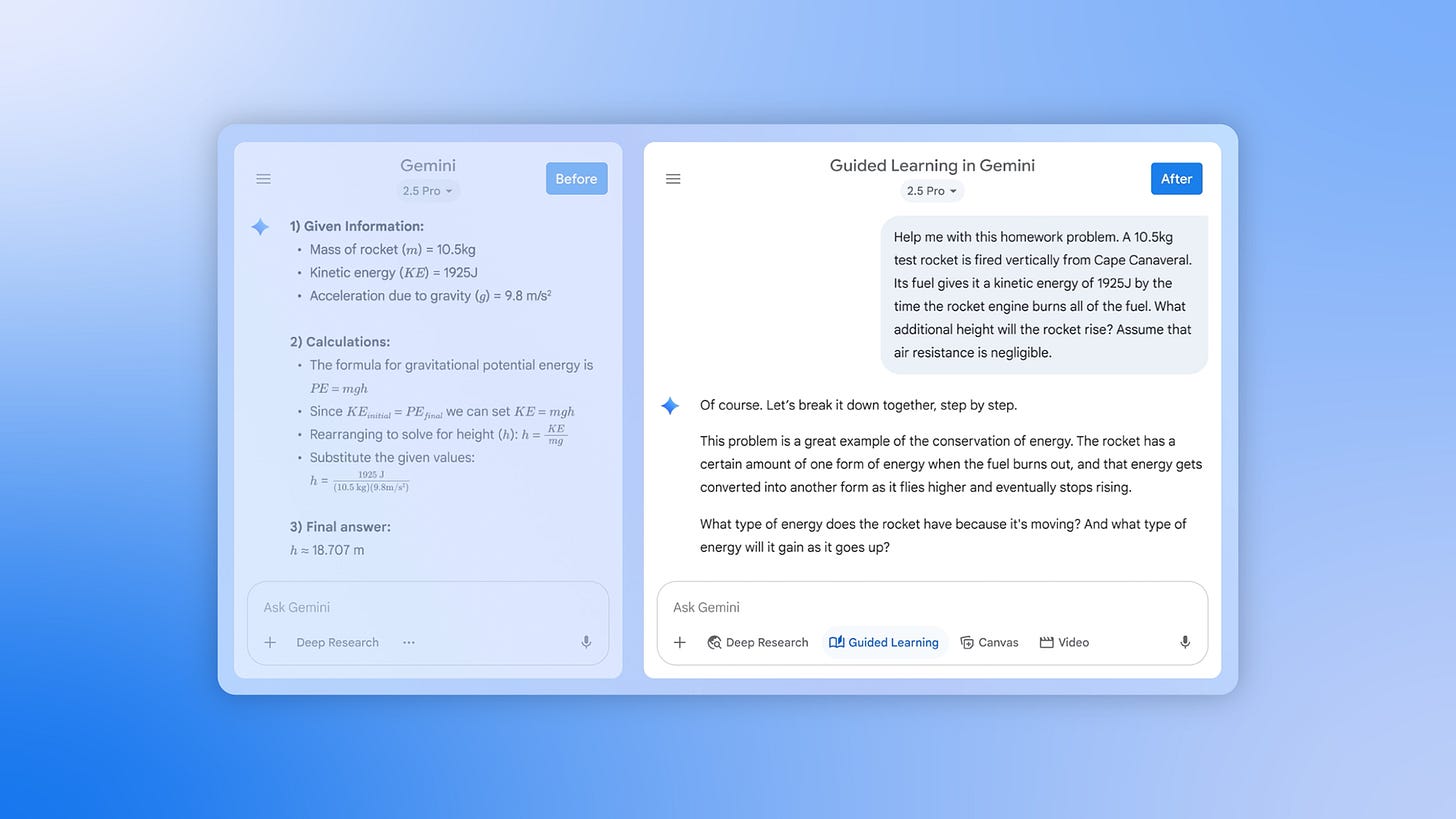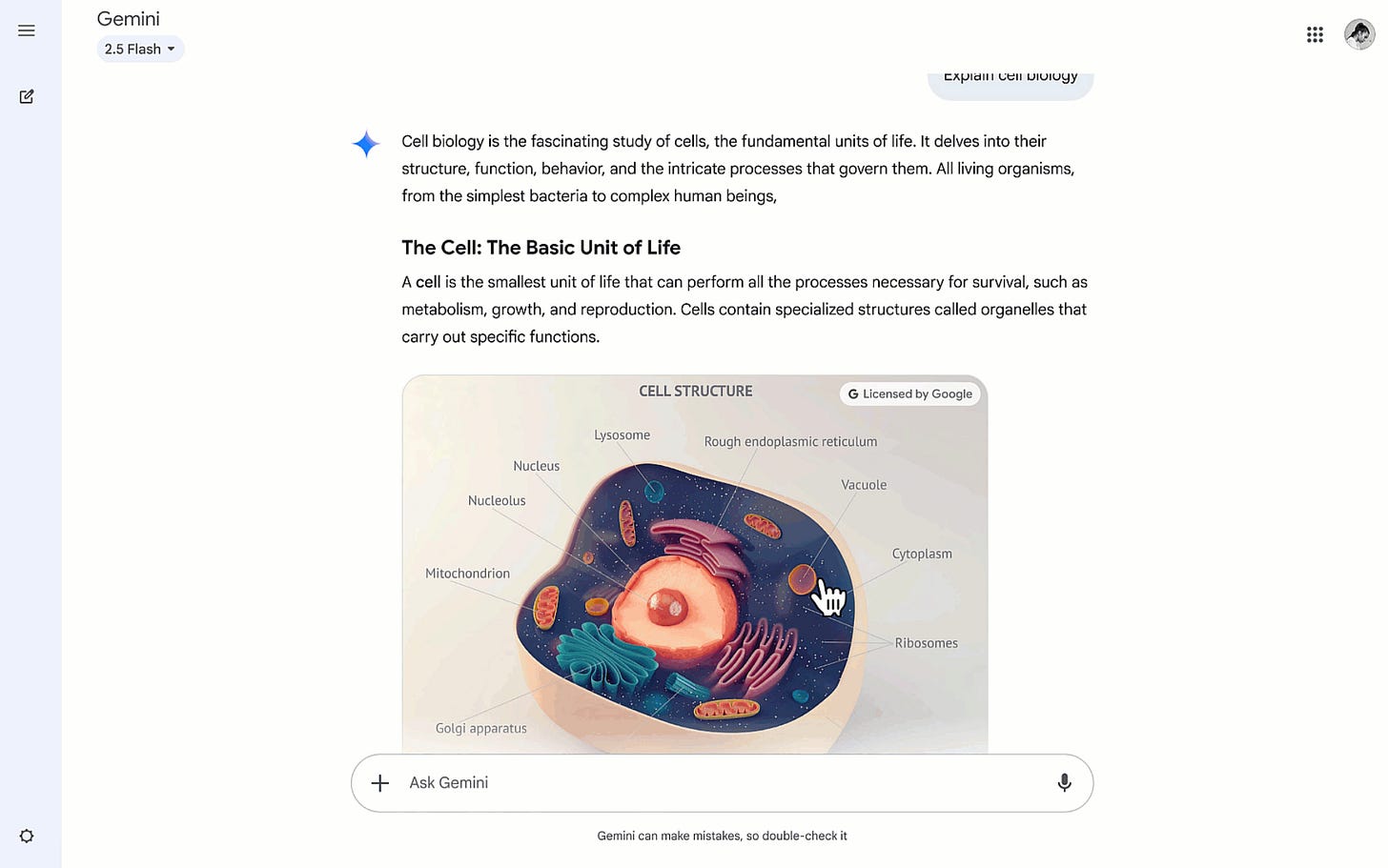BREAKING: Google introduces Guided Learning
Some thoughts on what could make Google's AI tutor stand out
🚨 Another major AI lab just launched “education mode” 🚨
Google introduced Guided Learning in Gemini, transforming it into a personalized learning companion designed to help you move from quick answers to real understanding.
Instead of immediately spitting out solutions, it:
Asks probing, open-ended questions
Walks learners through step-by-step reasoning
Adapts explanations to the learner’s level
Uses visuals, videos, diagrams, and quizzes to reinforce concepts
This Socratic style tutor rollout follows closely behind similar announcements like OpenAI’s Study Mode (last week) and Anthropic’s Claude for Education (April 2025).
Are any of these the perfect AI tutor yet? Not quite. Google, OpenAI, and Anthropic have all made impressive first moves with their education modes and I’m truly excited to see them invest in education. But these tools still share the same limitations I wrote about last week: minimal persistent memory, early over-structuring, and a tendency to agree too quickly. I don’t think it’s worth naming a “winner” given how early we are.
That said, I do think each lab does bring its own strategic angle to the space. In Google’s case, I believe that edge is its massive content surface area, deep Classroom integration, and multimodal delivery.
What’s unique about Guided Learning?
Similar to the other AI tutors rooted in Socratic principles, Guided Learning offers clear upgrades over default versions of chatbots (many of which I explored in last week’s breakdown of OpenAI’s Study Mode):
Step-by-step reasoning that encourages active engagement
Adaptive feedback tailored to the learner’s understanding
Structured scaffolding that builds toward mastery
A non-judgmental environment with low-stakes challenges
So what sets Gemini and Guided Learning apart?
LearnLM
While many AI “tutors” today are general-purpose models with clever prompts layered on (this is allegedly Study Mode’s according to a Redditor who jailbroke ChatGPT into revealing its underlying system prompt), Google built an entirely new model family LearnLM, fine-tuned specifically for education.
LearnLM is trained from the ground up to behave like a tutor. It’s been fine-tuned on human tutoring transcripts, role-played GenAI tutor-learner conversations, step-by-step math explanations (GSM8k), “golden” tutoring examples, and safety datasets for responsible use.
The result is a model that’s better at asking the right questions, adapting explanations, managing cognitive load, and resisting the urge to “just give the answer.” If you're curious, I did a deep dive on LearnLM when it first launched — you can find that here:
Google Classroom Integration
While Study Mode and Claude for Education are primarily individual-facing tools, Google is clearly thinking about how to integrate with real classrooms.
Educators can now generate custom Guided Learning links tied to specific topics or concepts. These links can be posted as assignments or supplemental materials, or shared with individual students or groups.
In the structure of a real classroom - with pacing, scope, and curricular goals -students are more likely to ask follow-ups and build real understanding. And Google has privileged access to that structure through Google Classroom, giving it rare context into what students are learning, when, and how well.
Context Matters
Google’s access to structured classroom data is a contextual goldmine for adaptive learning. If data-sharing permissions are granted, here’s what Gemini could potentially tap into:
Course Structure (syllabus outlines, lesson plans, modules, assignments):
Gives the model a semantic map of the course: what’s being taught, when, and with what emphasis
Enables just-in-time scaffolding and highlights prerequisite gaps
Assignments & Submissions (homework, rubrics, student drafts)
Offers a longitudinal view of each student’s thinking and writing
Supports personalized feedback, revision strategies, and growth tracking
Grading & Assessments (formative/summative assessments, teacher feedback)
Reveals patterns of mastery and struggle
Could allow LearnLM to adapt pacing dynamically - slowing down or advancing based on individual student progress
Together, these data points can create persistent learner profiles that inform how the AI scaffolds future interactions, tailoring instruction based on what the student has already attempted or mastered.
Of course, all of this is conditional on school or district-level data permissions and must remain compliant with COPPA, FERPA, and other student privacy protections . But if granted, it gives Google a classroom integration advantage no other AI lab can currently match.
Google’s Content Surface Area is its Secret Weapon
One of Google’s biggest advantages isn’t just its model, it’s the breadth and depth of content it can surface across its ecosystem. From YouTube to Search to NotebookLM to Classroom, Google’s ecosystem lets it deliver rich, multimodal learning experiences that go far beyond text.
NotebookLM is evidence of Google’s ability to build multimodal, structured learning tools that include mind maps, audio summaries, and more. (Also now available to users under 18 as of yesterday!)
YouTube
While ChatGPT and Claude may use text or visualizations to describe a physics concept, Gemini can show it via YouTube videos from trusted educators. Google can also embed these videos directly into the Guided Learning experience, selecting content based on watch time, clarity, and engagement signals.
No other company in the AI race owns a platform as structured, searchable, and engagement-optimized as YouTube.
Licensed Visuals
Beyond video, Guided Learning can also surface licensed and verified educational visuals. This is especially powerful in STEM, geography, and other visually intensive subjects.
These visuals can include educational diagrams and labeled illustrations, or interactive concept maps that scaffold understanding. Because this content is indexed, ranked, and curated for quality through Google Image and Search, it's inherently less prone to hallucination and aligned with how students visually process complex material.
Distribution + Modality
Google controls two of the most powerful distribution funnels in education:
YouTube: the world’s default platform for video-based learning
Search: the starting point for problem-solving, exploration, and curiosity
Instead of sending students to seek out diagrams, videos, or quizzes on their own, Google could weave these into a seamless, adaptive flow:
→ Student asks question
→ Text-based explanation
→ Supporting diagram
→ YouTube walkthrough
→ Quiz to reinforce learning
All inside one interface.
Because Google owns the infrastructure across nearly every learning modality (text, speech, video, images, structured data, and assessment), it’s uniquely positioned to build an intelligent, closed-loop learning system that is (1) context-aware, (2) feedback-driven, and (3) visually immersive.
Google has a particularly interesting edge. Not necessarily because the current experience or product is miles ahead, but because of the infrastructure it could leverage.
All the major labs are still figuring out what great AI tutoring actually looks like. But if multimodality, classroom integration and context, and content surface area are key ingredients, Google could be well positioned to experiment at scale.





Brilliant! Thank you.
Again, brilliant reflections! Thank you for sharing!